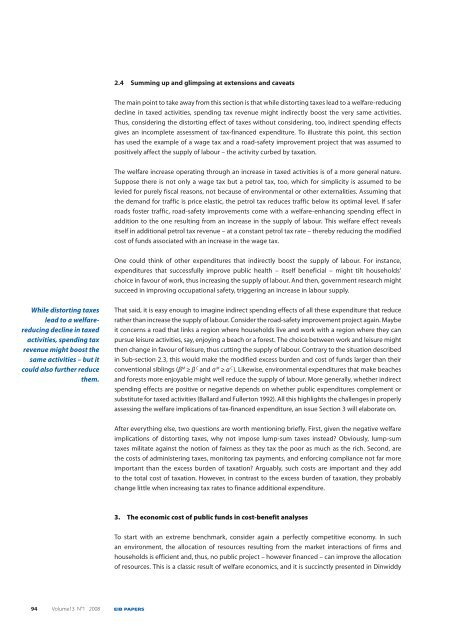EIB Papers Volume 13. n°1/2008 - European Investment Bank
EIB Papers Volume 13. n°1/2008 - European Investment Bank
EIB Papers Volume 13. n°1/2008 - European Investment Bank
You also want an ePaper? Increase the reach of your titles
YUMPU automatically turns print PDFs into web optimized ePapers that Google loves.
While distorting taxes<br />
lead to a welfarereducing<br />
decline in taxed<br />
activities, spending tax<br />
revenue might boost the<br />
same activities – but it<br />
could also further reduce<br />
them.<br />
94 <strong>Volume</strong>13 N°1 <strong>2008</strong> <strong>EIB</strong> PAPERS<br />
2.4 Summing up and glimpsing at extensions and caveats<br />
The main point to take away from this section is that while distorting taxes lead to a welfare-reducing<br />
decline in taxed activities, spending tax revenue might indirectly boost the very same activities.<br />
Thus, considering the distorting effect of taxes without considering, too, indirect spending effects<br />
gives an incomplete assessment of tax-financed expenditure. To illustrate this point, this section<br />
has used the example of a wage tax and a road-safety improvement project that was assumed to<br />
positively affect the supply of labour – the activity curbed by taxation.<br />
The welfare increase operating through an increase in taxed activities is of a more general nature.<br />
Suppose there is not only a wage tax but a petrol tax, too, which for simplicity is assumed to be<br />
levied for purely fiscal reasons, not because of environmental or other externalities. Assuming that<br />
the demand for traffic is price elastic, the petrol tax reduces traffic below its optimal level. If safer<br />
roads foster traffic, road-safety improvements come with a welfare-enhancing spending effect in<br />
addition to the one resulting from an increase in the supply of labour. This welfare effect reveals<br />
itself in additional petrol tax revenue – at a constant petrol tax rate – thereby reducing the modified<br />
cost of funds associated with an increase in the wage tax.<br />
One could think of other expenditures that indirectly boost the supply of labour. For instance,<br />
expenditures that successfully improve public health – itself beneficial – might tilt households’<br />
choice in favour of work, thus increasing the supply of labour. And then, government research might<br />
succeed in improving occupational safety, triggering an increase in labour supply.<br />
That said, it is easy enough to imagine indirect spending effects of all these expenditure that reduce<br />
rather than increase the supply of labour. Consider the road-safety improvement project again. Maybe<br />
it concerns a road that links a region where households live and work with a region where they can<br />
pursue leisure activities, say, enjoying a beach or a forest. The choice between work and leisure might<br />
then change in favour of leisure, thus cutting the supply of labour. Contrary to the situation described<br />
in Sub-section 2.3, this would make the modified excess burden and cost of funds larger than their<br />
conventional siblings (β M ≥ β C and α M ≥ α C ). Likewise, environmental expenditures that make beaches<br />
and forests more enjoyable might well reduce the supply of labour. More generally, whether indirect<br />
spending effects are positive or negative depends on whether public expenditures complement or<br />
substitute for taxed activities (Ballard and Fullerton 1992). All this highlights the challenges in properly<br />
assessing the welfare implications of tax-financed expenditure, an issue Section 3 will elaborate on.<br />
After everything else, two questions are worth mentioning briefly. First, given the negative welfare<br />
implications of distorting taxes, why not impose lump-sum taxes instead? Obviously, lump-sum<br />
taxes militate against the notion of fairness as they tax the poor as much as the rich. Second, are<br />
the costs of administering taxes, monitoring tax payments, and enforcing compliance not far more<br />
important than the excess burden of taxation? Arguably, such costs are important and they add<br />
to the total cost of taxation. However, in contrast to the excess burden of taxation, they probably<br />
change little when increasing tax rates to finance additional expenditure.<br />
3. The economic cost of public funds in cost-benefit analyses<br />
To start with an extreme benchmark, consider again a perfectly competitive economy. In such<br />
an environment, the allocation of resources resulting from the market interactions of firms and<br />
households is efficient and, thus, no public project – however financed – can improve the allocation<br />
of resources. This is a classic result of welfare economics, and it is succinctly presented in Dinwiddy

















